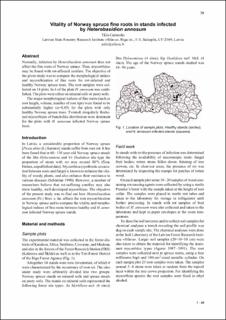| dc.contributor.author | Gaitnieks, Talis | |
| dc.date.accessioned | 2020-07-03T10:57:30Z | |
| dc.date.available | 2020-07-03T10:57:30Z | |
| dc.date.issued | 2006 | |
| dc.identifier.issn | 0803-284X | |
| dc.identifier.uri | https://hdl.handle.net/11250/2660697 | |
| dc.description.abstract | Normally, infection by Heterobasidion annosum does not
affect the fine roots of Norway spruce. Thus, mycorrhizas
may be found with rot-affected conifers. The objective of
the given study was to compare the morphological indices
and mycorrhization of fine roots for rot-infected and
healthy Norway spruce trees. The root samples were collected
on 14 plots. In 6 of the plots H. annsoum was established.
The plots were either on mineral soils or peaty soils.
The major morphological indices of fine roots (such as
root length, volume, number of root tips) were found to be
substantially higher (�����=0,05) for the plots with only
healthy Norway spruce trees. Twisted, irregularly thickened
mycorrhizas of bunch-like distribution were dominant
for the plots with H. annosum infected Norway spruce
trees. | en_US |
| dc.language.iso | eng | en_US |
| dc.publisher | Norsk institutt for skogforskning | en_US |
| dc.relation.ispartofseries | Aktuelt fra Skogforskningen;1/06 | |
| dc.title | Vitality of Norway spruce fine roots in stands infected by Heterobasidion annosum | en_US |
| dc.type | Journal Article | en_US |
| dc.description.version | publishedVersion | en_US |
| dc.subject.nsi | VDP::Landbruks- og Fiskerifag: 900::Landbruksfag: 910::Skogbruk: 915 | en_US |
| dc.source.pagenumber | 79-82 | en_US |
| dc.source.journal | Aktuelt fra Skogforskningen | en_US |
| dc.source.issue | 1/06 | en_US |
